Crafting
new ways to consider Harewood House at its third biennial of art & design
In the third edition of the Harewood Biennial, the
architecture, interiors & landscapes of Yorkshire’s 18th century
Harewood House are considered by international artists & designers. Under the curatorial
framing of Create/Elevate, the history and ornate decoration of the place is explored
with creativity & wit.
Sited halfway between Leeds and Harrogate is the enormous
neoclassical stately pile of Harewood House. Designed by locally-born architect
John Carr, the interior features ceilings, friezes, and chimney pieces designed
by Robert Adam, furniture from Thomas Chippendale, with art from the likes of Joshua
Reynolds and Thomas Gainsborough, with Sèvres porcelain in ornate cabinetry. Outside,
an Italianate terrace, designed by Charles Barry in the 1840s, connects through
to a vast Capability Brown design landscape spreading far beyond the 32-acre
serpentine lake in view from the house.
The whole place was built by Henry Lascelles, funded by profits he made in the West Indian sugar trade – including 27,000 acres of plantations, ships, warehouses, and almost 3,000 slaves. The Yorkshire estate is still owned by the Lascelles family and since the 1950s the whole place has opened up more and more to the public, first for classical music festivals and growing to now be open most of the year with a programme encompassing access to the house and gardens, now including artisan markets, food festivals, motor shows as well as a mix of activities from an adventure playground to critically engaging contemporary art interventions.
The whole place was built by Henry Lascelles, funded by profits he made in the West Indian sugar trade – including 27,000 acres of plantations, ships, warehouses, and almost 3,000 slaves. The Yorkshire estate is still owned by the Lascelles family and since the 1950s the whole place has opened up more and more to the public, first for classical music festivals and growing to now be open most of the year with a programme encompassing access to the house and gardens, now including artisan markets, food festivals, motor shows as well as a mix of activities from an adventure playground to critically engaging contemporary art interventions.

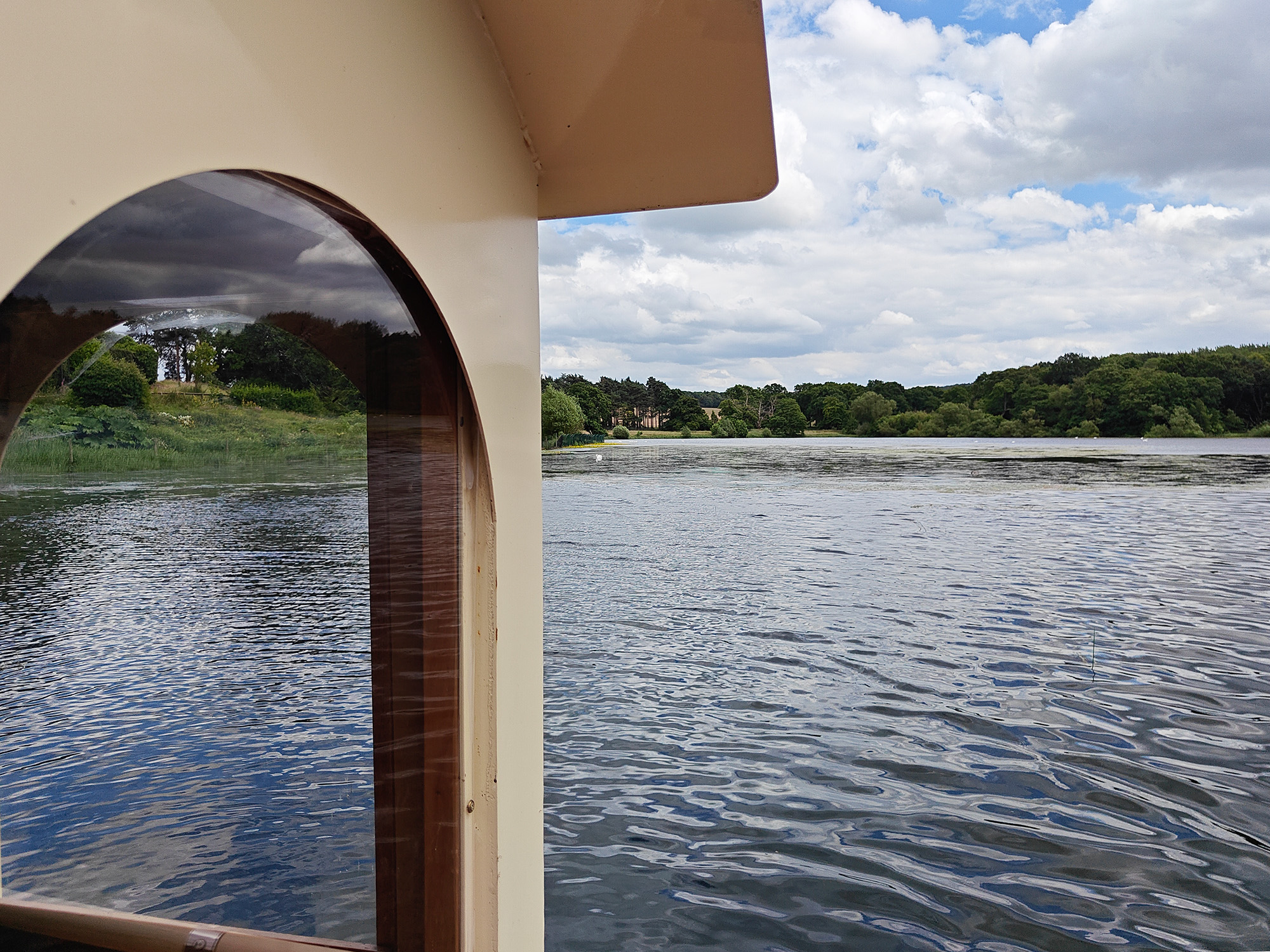


Figs.i-iv
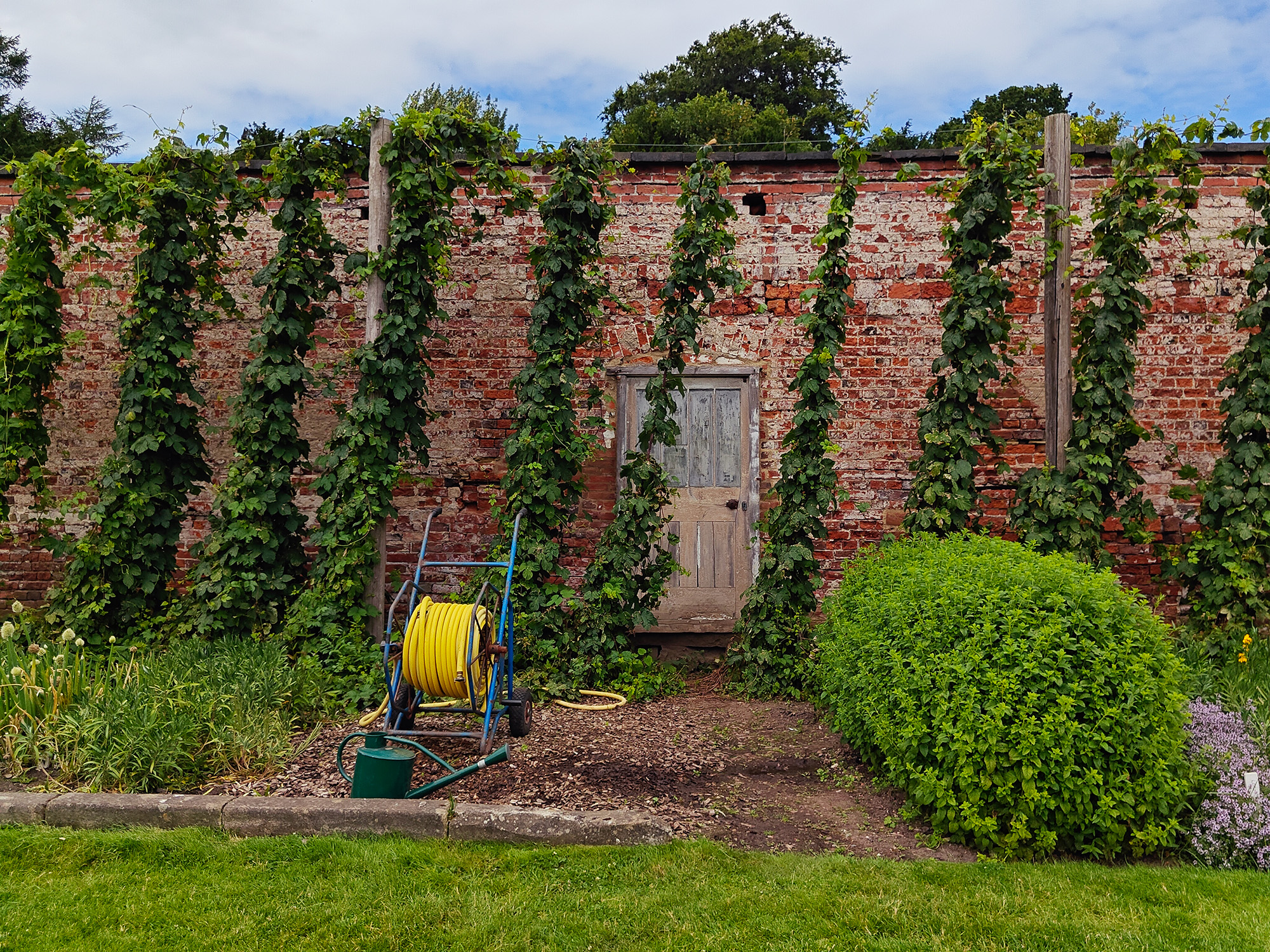


Figs.v-vii
In 2022, Tate Liverpool mounted the exhibition Radical
Landscapes, looking afresh at romantic notions of the British pastoral
through a lens of activism, trespass, climate, and colonialism. It was curated
by Darren Pih, who then took up a role at Harewood House as Chief Curator and
Artistic Director. Pih has since moved on to become Head of Exhibitions &
Collections at Manchester’s Whitworth, but the conversation initiated at Tate
Liverpool is present throughout his curation of 2024’s Harewood Biennial, subtitled Create/Elevate and which brings together 16 local and international artists and designers, with many considering
colonial history and its connection to the house and garden the works are sited
within.
Co-curated with Ligaya Salazar, the edition takes three interwoven themes of: New Narratives, reconsidering Harewood House’s design and collection history; The Use of Land, looking into ecology; and Nourish, thinking how sharing of food facilitates the sharing of knowledge. Two of the works are placed in the landscape, with most taking over the grand suite of rooms comprising the visitor route, with some deftly speaking to the historic setting and loaded histories, and others taking over the space, visually and conceptually confronting the past and its values with new ideas and contextualisation.
Here, we pick out some of the highlights.
Co-curated with Ligaya Salazar, the edition takes three interwoven themes of: New Narratives, reconsidering Harewood House’s design and collection history; The Use of Land, looking into ecology; and Nourish, thinking how sharing of food facilitates the sharing of knowledge. Two of the works are placed in the landscape, with most taking over the grand suite of rooms comprising the visitor route, with some deftly speaking to the historic setting and loaded histories, and others taking over the space, visually and conceptually confronting the past and its values with new ideas and contextualisation.
Here, we pick out some of the highlights.
Conditions
at Present (2023)
Rebecca Chesney
In late 2023, we featured the work of Rebecca Chesney when featured in a Lubaina Himid-curated exhibition at HOME (00143). There, the artist presented a textile work wrapping derived from planning applications as a form of documentation of central Manchester, and here her stitching skills again with a cluster of 25 fluttering windsocks. They are all made of reclaimed fabric from tents abandoned after music festivals in a discussion upon the wastefulness of late capitalism’s single-use addiction and the inequalities inherent within who has access to a place of sanctitude and a place to sleep.
Chesney worked with the charity Festival Waste Reclamation and Distribution who work to reduce and divert music festival waste. While brightly coloured, glowing against the Harewood green, the material of the tent windsocks is a plastic non-biodegradable fibre
Rebecca Chesney
In late 2023, we featured the work of Rebecca Chesney when featured in a Lubaina Himid-curated exhibition at HOME (00143). There, the artist presented a textile work wrapping derived from planning applications as a form of documentation of central Manchester, and here her stitching skills again with a cluster of 25 fluttering windsocks. They are all made of reclaimed fabric from tents abandoned after music festivals in a discussion upon the wastefulness of late capitalism’s single-use addiction and the inequalities inherent within who has access to a place of sanctitude and a place to sleep.
Chesney worked with the charity Festival Waste Reclamation and Distribution who work to reduce and divert music festival waste. While brightly coloured, glowing against the Harewood green, the material of the tent windsocks is a plastic non-biodegradable fibre
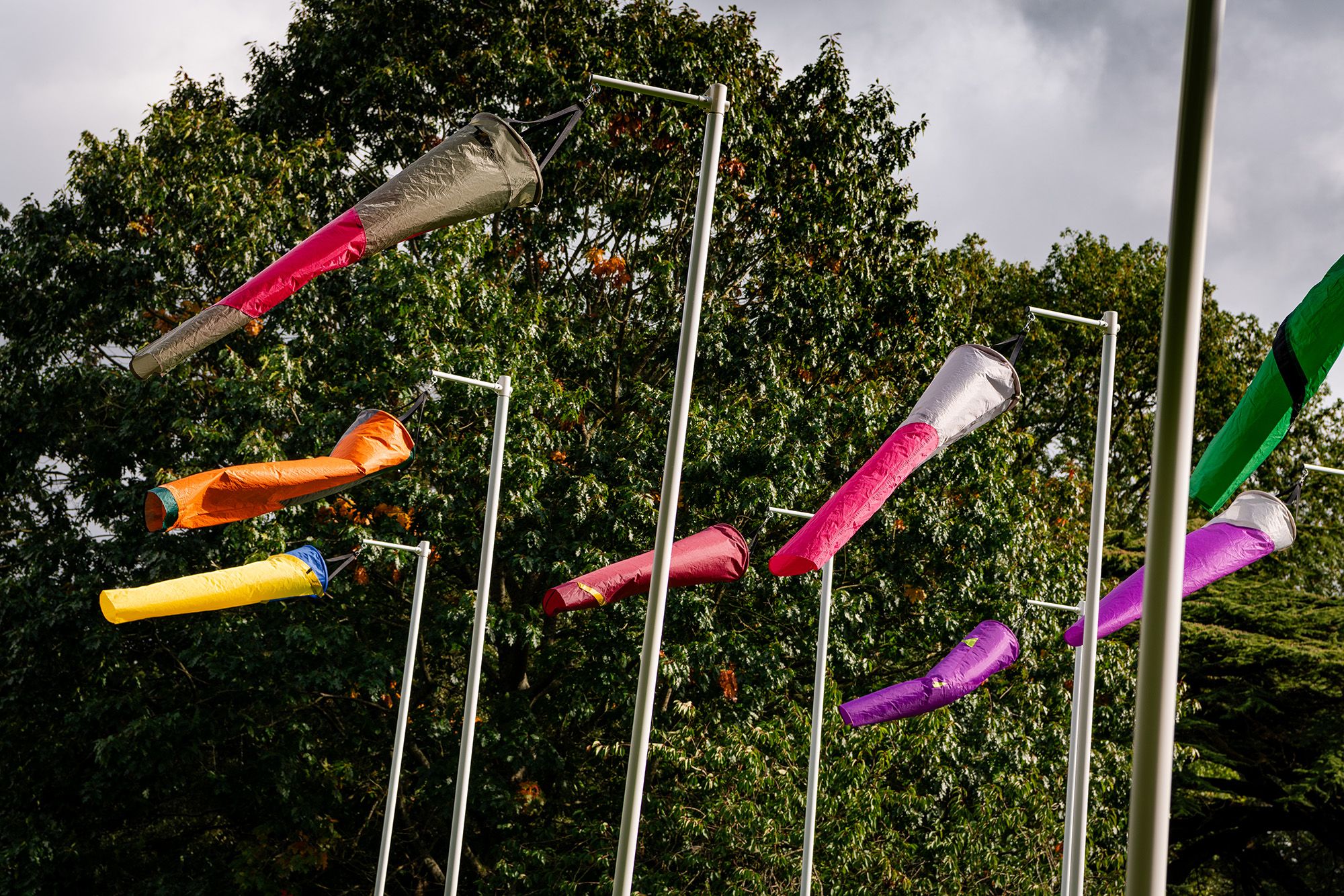
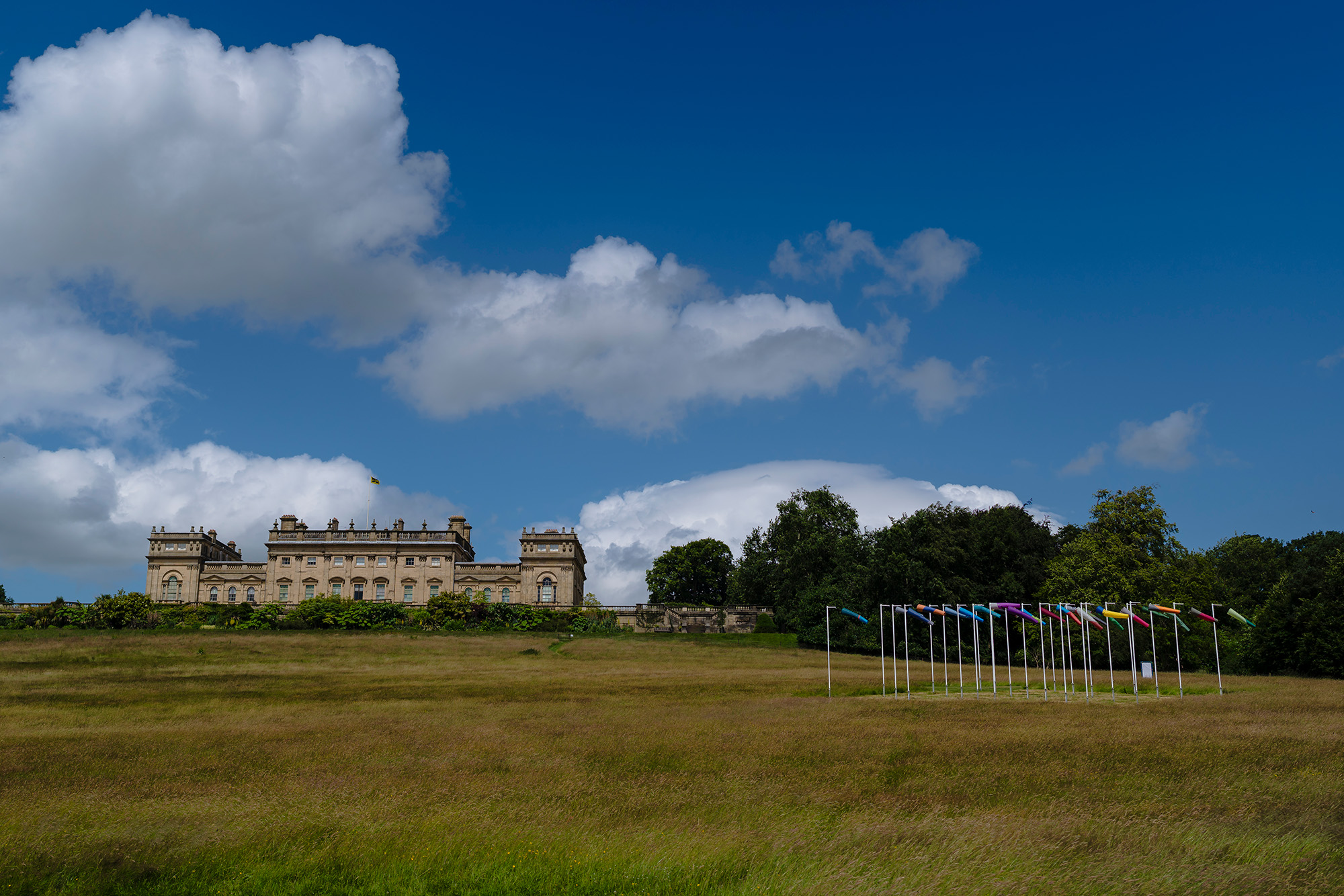
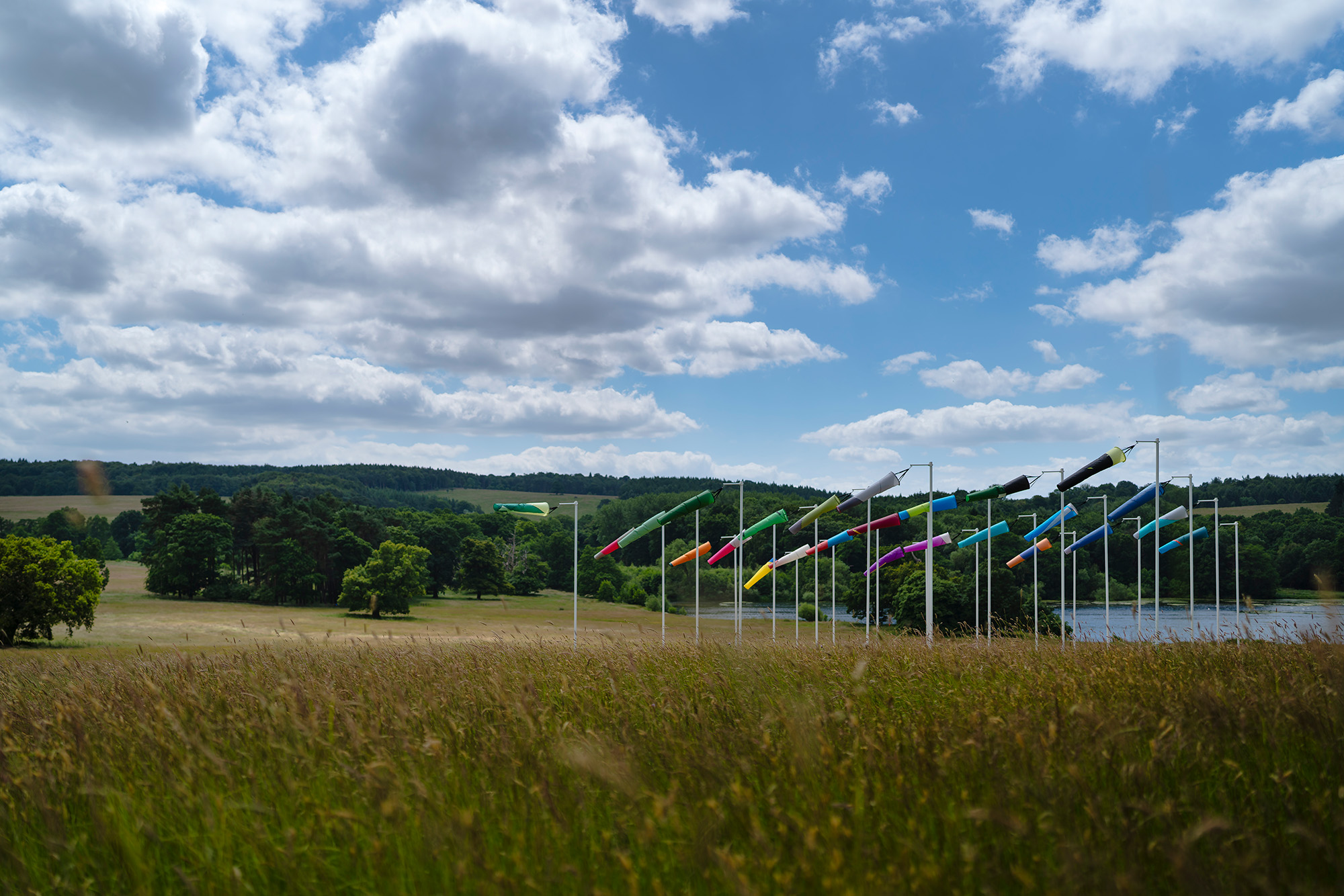
Figs.viii-x
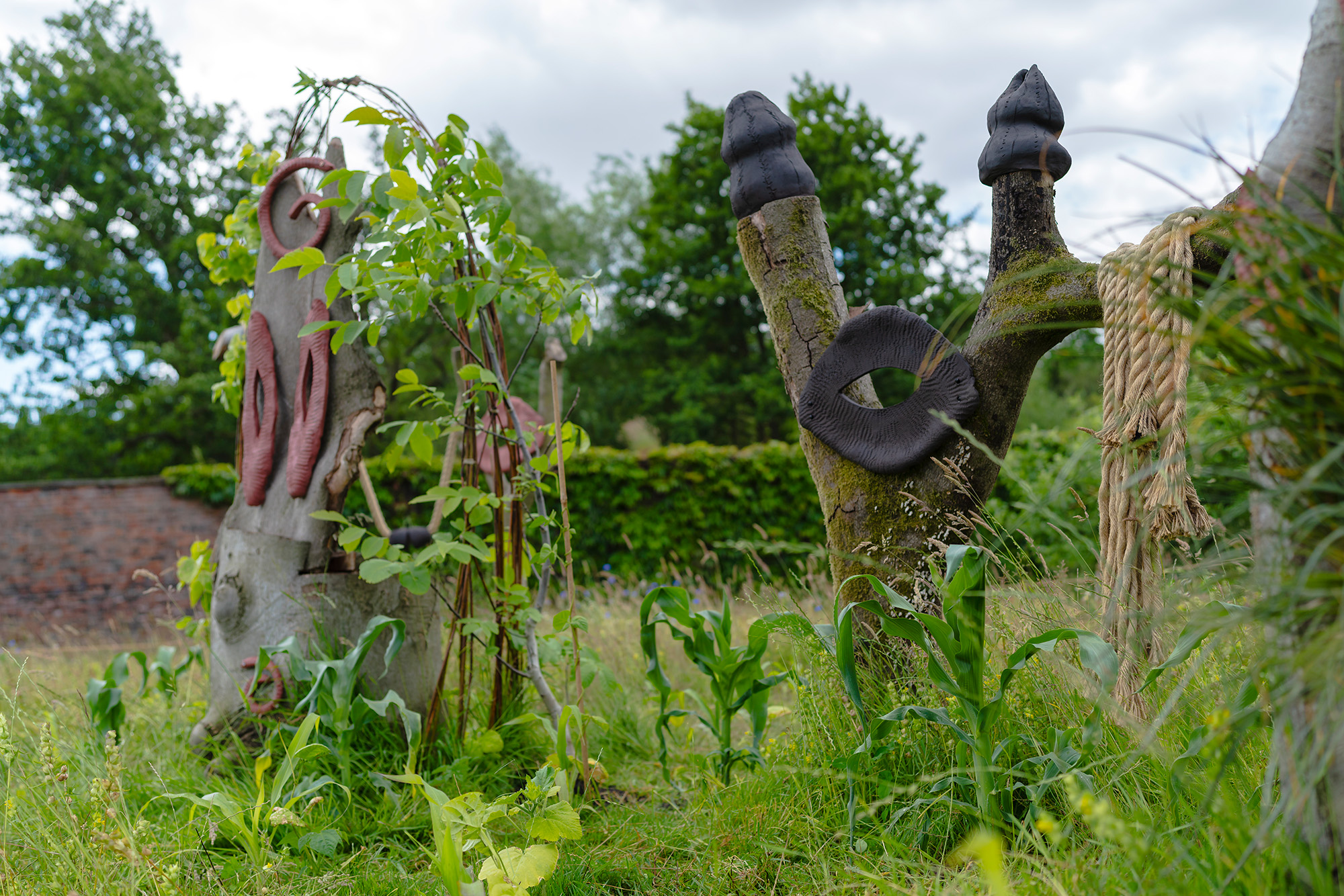

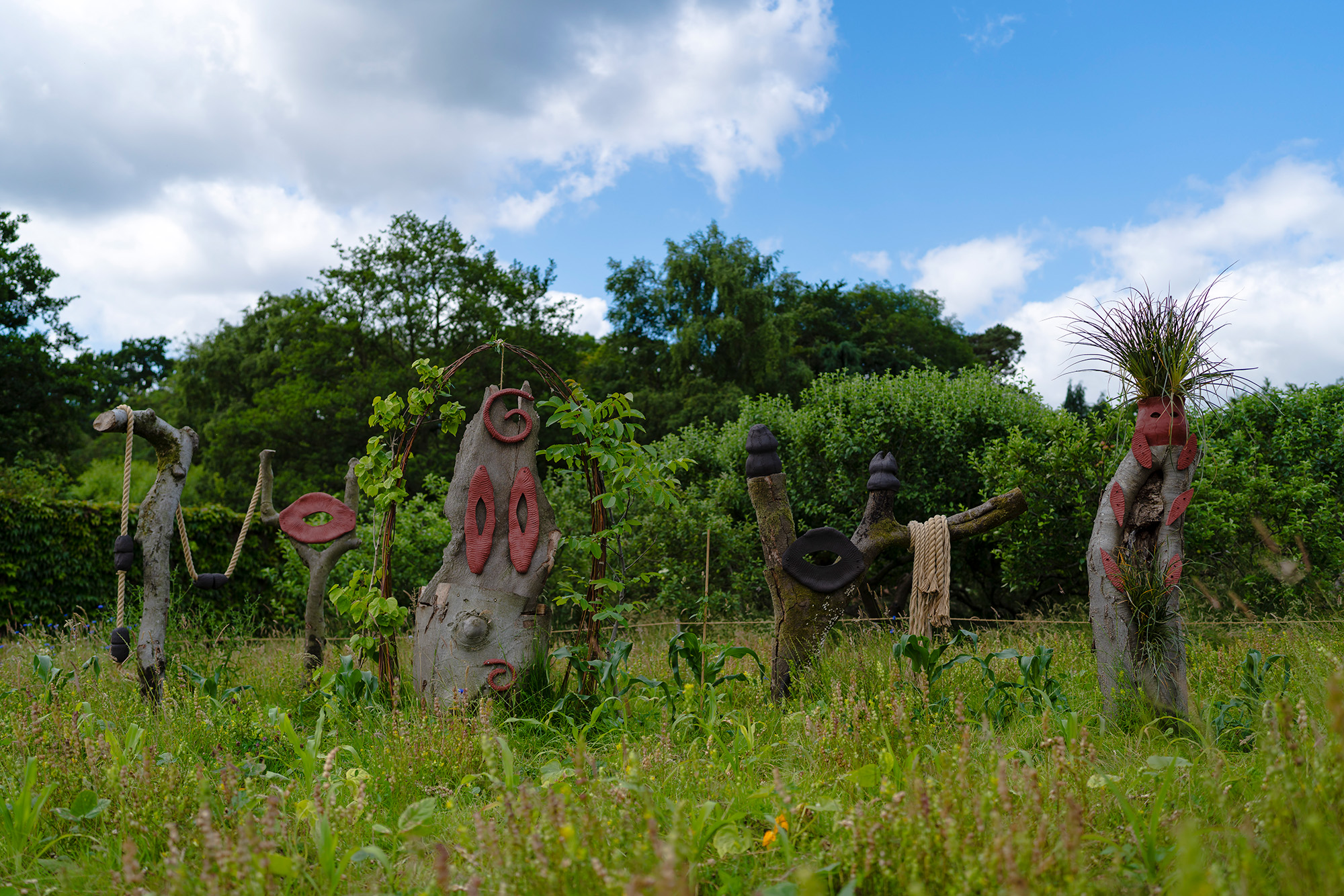
Figs.xi-xiii
Cultivo y Memorio (2024)
Lucia Pizzani
The second work sited outside of the house is by Venezuelan London-based artist Lucia Pizzani who has collaborated with Harewood’s Head Gardener Trevor Nicholson to create a group of living sculptures. Found in the walled vegetable garden – requiring a free boat across Capability Brown’s lake for the quickest route from the house – the work refers to the ancestral Mesoamerican “three sisters” method of planting, whereby corn, beans, and squash grow in proximity, complementing each other’s nurturing needs.
Once feeding the whole estate and Lascelles family, the walled garden still provides produce for the visitor café, with the new anthropomorphic sculptures formed of fallen trees also providing foodstuffs as the artworks evolve over the summer months. There are also ceramic elements playfully positioned around the arboreal fragments, with Pizzani folding together horticultural practice with spirituality, and mingling Mayan and UK vegetal thinking.
Lucia Pizzani
The second work sited outside of the house is by Venezuelan London-based artist Lucia Pizzani who has collaborated with Harewood’s Head Gardener Trevor Nicholson to create a group of living sculptures. Found in the walled vegetable garden – requiring a free boat across Capability Brown’s lake for the quickest route from the house – the work refers to the ancestral Mesoamerican “three sisters” method of planting, whereby corn, beans, and squash grow in proximity, complementing each other’s nurturing needs.
Once feeding the whole estate and Lascelles family, the walled garden still provides produce for the visitor café, with the new anthropomorphic sculptures formed of fallen trees also providing foodstuffs as the artworks evolve over the summer months. There are also ceramic elements playfully positioned around the arboreal fragments, with Pizzani folding together horticultural practice with spirituality, and mingling Mayan and UK vegetal thinking.
Layered Legacies (2024)
Mani Kambo
Pizzani’s work was one of four new commissions by the Biennial, with Mani Kimbo’s graphic takeover of a room in the house with site-responsive wallpaper. The repeating design references artists and works from the house and its collection discovered through the artist’s research. Included are floral and landscape motifs of Armenian ceramicist David Ohannessian’s 1920s works, urn and palmette forms found within works at Harewood’s related to ancient Egypt, and a fret lattice pattern derived from anonymously-made hand-crafted 18th century Chinese wallpaper in the adjoining bedroom.
A fingerprint motif is incorporated into the wallpaper design, picking up from a fingerprint Kambo noticed in the Robert Adam plaster ceiling above, incorporated by the artist to honour the craftsperson at the centre of making at all scales. True to this, the wallpaper itself was hand printed using traditional block craft techniques
The interplay of historic tradition and stark graphic contemporary speaks deeply to the critical approach of the Biennial through analysis of the embedded global, interconnected histories and presenting them afresh.
Mani Kambo
Pizzani’s work was one of four new commissions by the Biennial, with Mani Kimbo’s graphic takeover of a room in the house with site-responsive wallpaper. The repeating design references artists and works from the house and its collection discovered through the artist’s research. Included are floral and landscape motifs of Armenian ceramicist David Ohannessian’s 1920s works, urn and palmette forms found within works at Harewood’s related to ancient Egypt, and a fret lattice pattern derived from anonymously-made hand-crafted 18th century Chinese wallpaper in the adjoining bedroom.
A fingerprint motif is incorporated into the wallpaper design, picking up from a fingerprint Kambo noticed in the Robert Adam plaster ceiling above, incorporated by the artist to honour the craftsperson at the centre of making at all scales. True to this, the wallpaper itself was hand printed using traditional block craft techniques
The interplay of historic tradition and stark graphic contemporary speaks deeply to the critical approach of the Biennial through analysis of the embedded global, interconnected histories and presenting them afresh.
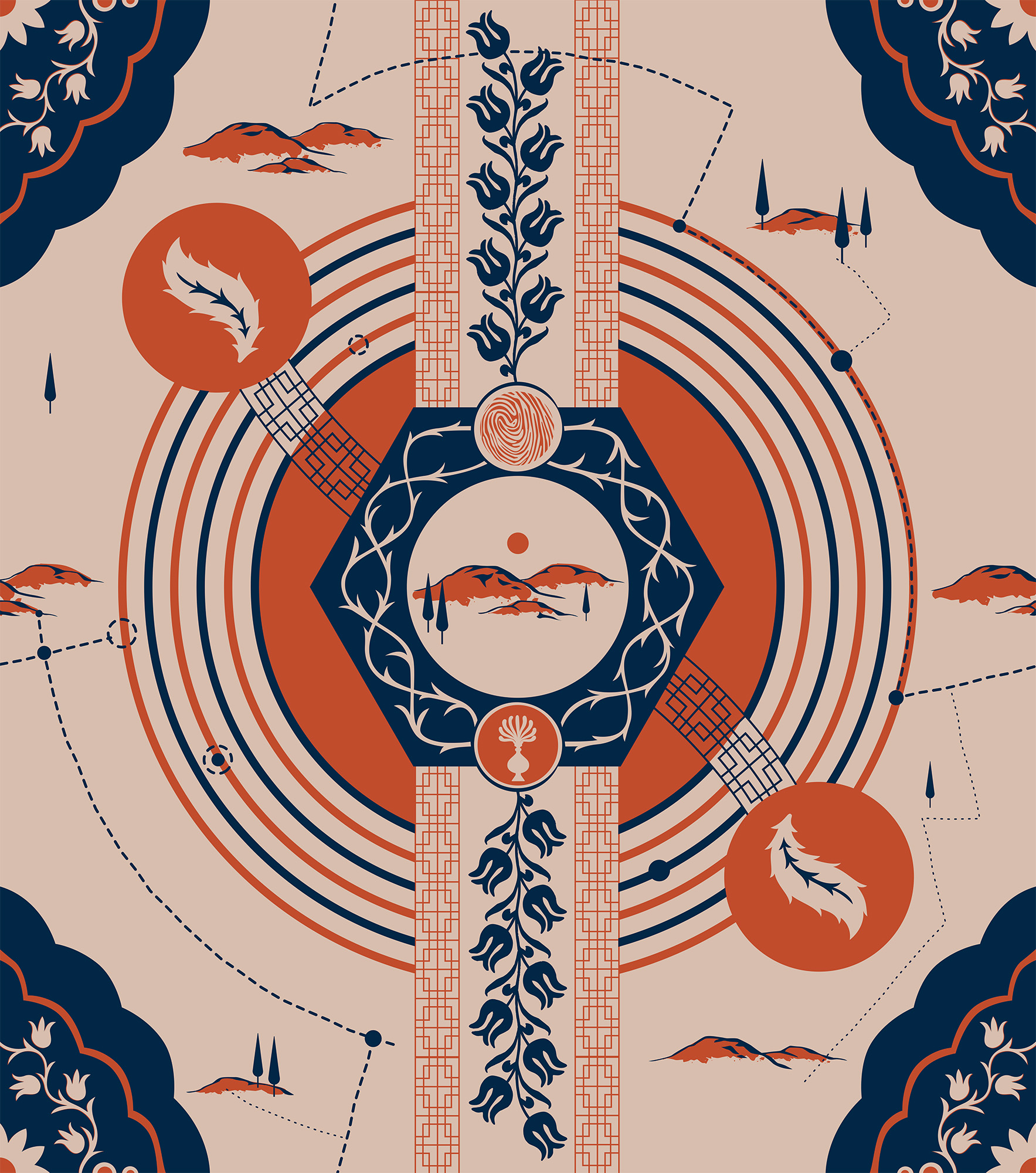
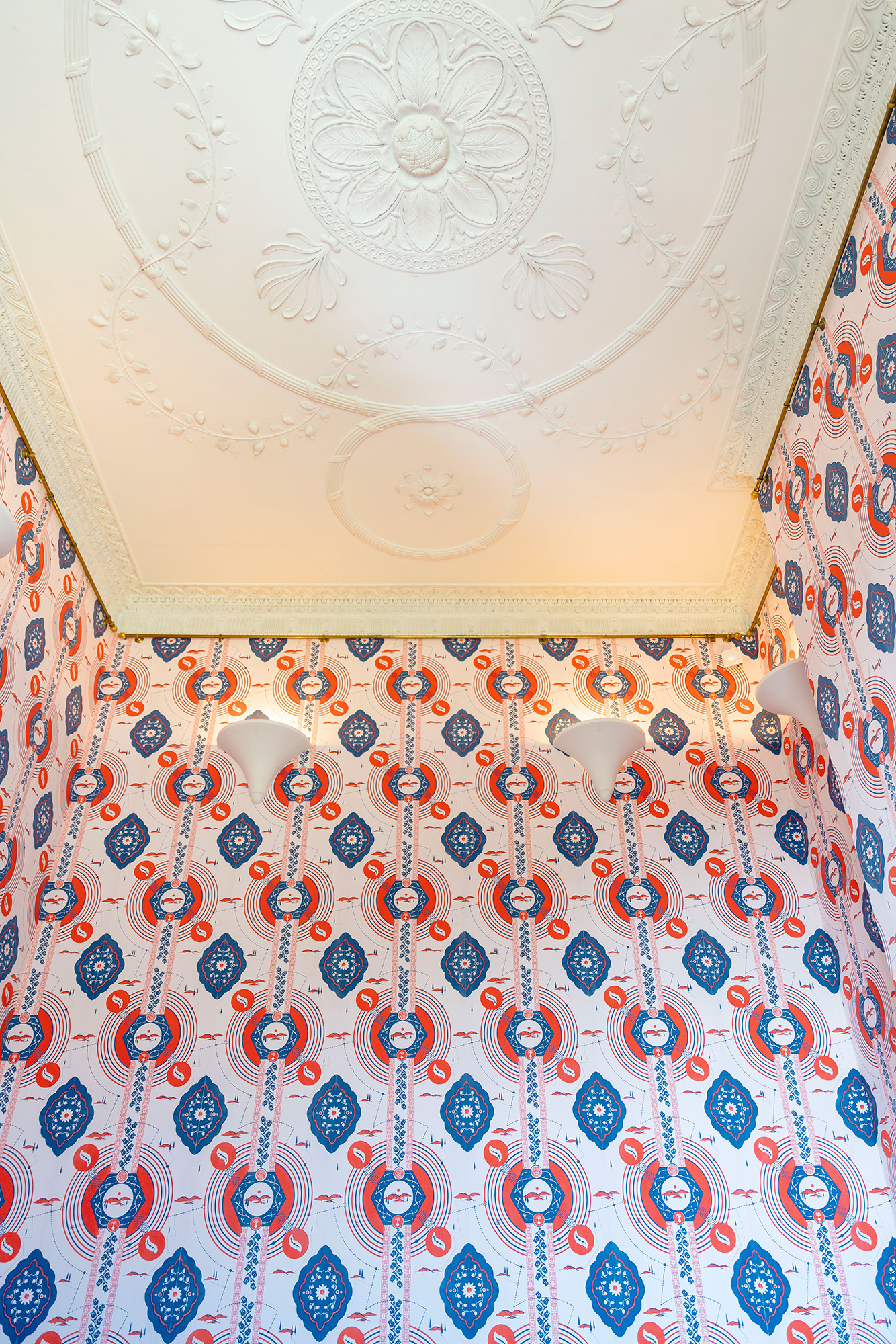
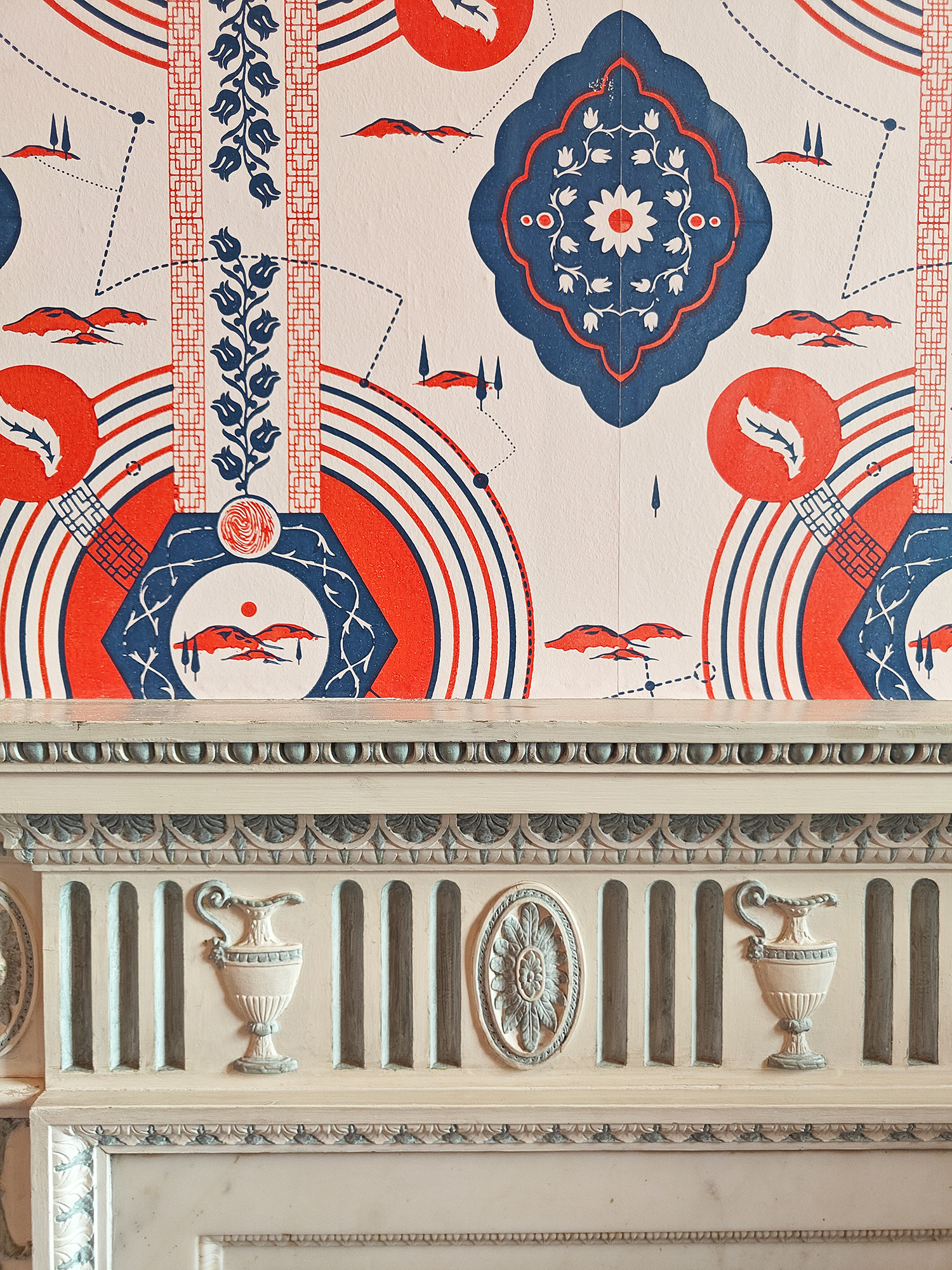
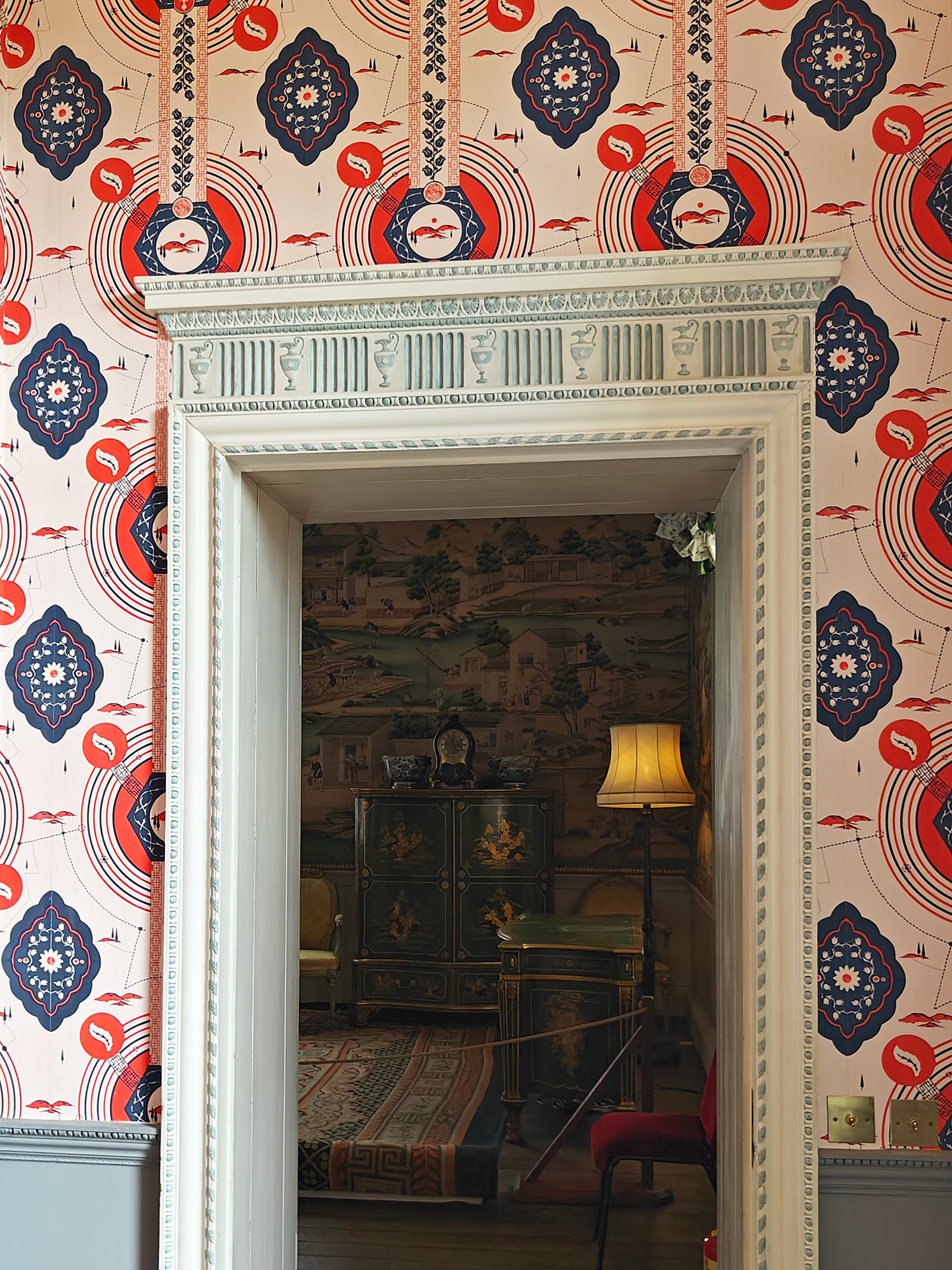
Figs.xiv-xviii
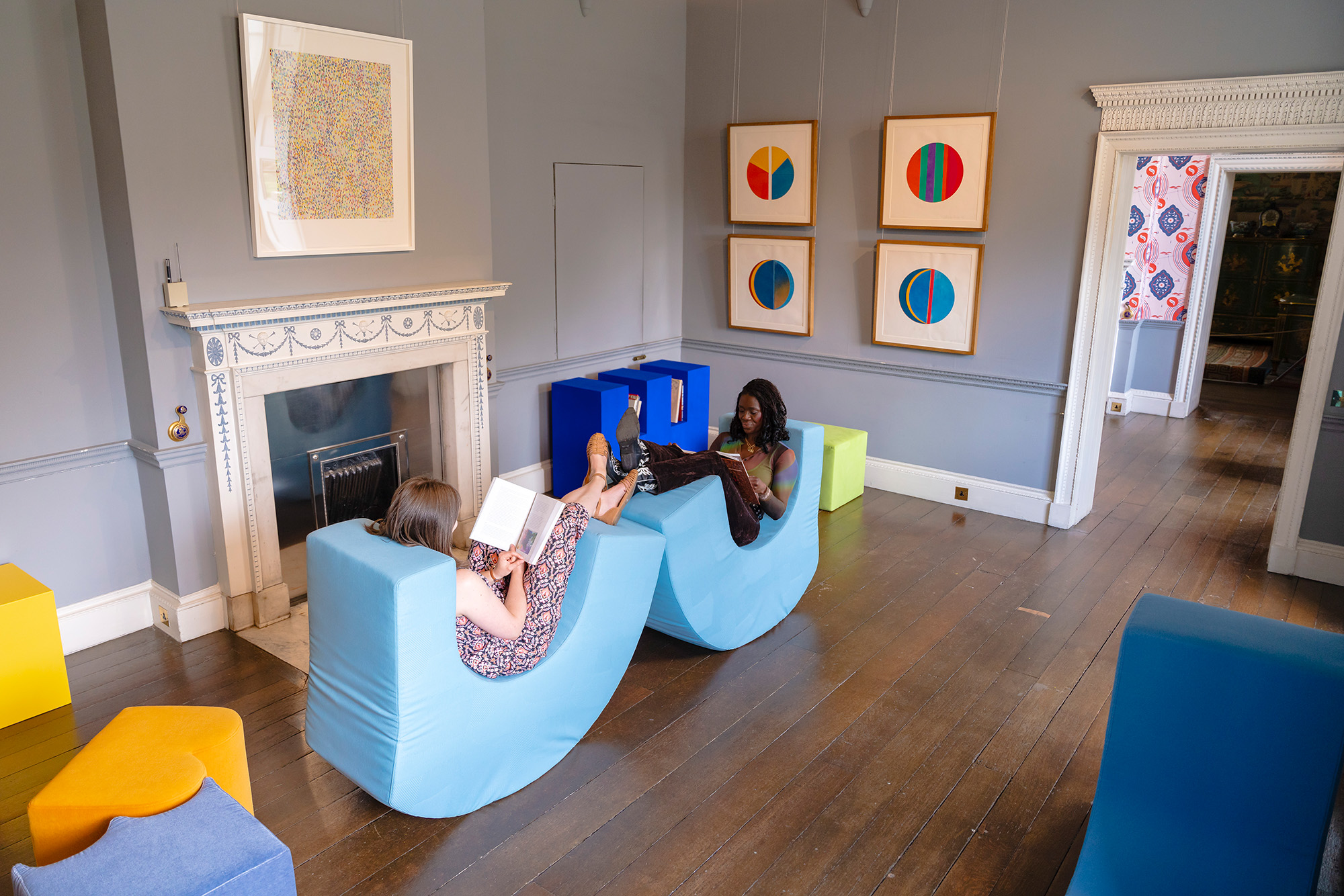



Figs.xix-xxii
Social Kitchen (2024)
Arabeschi Di Latte & Jo Woffinden
&
Onipa ye de (Huam being is sweet) (2024)
Modular by Mensah
The two other commissions cover different forms of material and making. Arabeschi Di Latte is a design studio founded by Francesca Sarti in Florence in 2001, based in London since 2013. Working with Leeds-based ceramicist Jo Woffinden, Sarti has created sharing dishes inspired by histories of communal dining and socialising. Set within the house’s kitchen, the pieces are poetically absurd, but remind of different ways of eating and sharing across time and place.
Kusheda Mensah is a London-based British-born Ghanaian designer with interest in public use of space. Her installation comprises a series of modular furniture pieces derived from an Akan language proverb. Transformed into graphical, soft furnishings that invite new ways of sitting and being with others, there is space within the design to hold books from the Harewood House collection as a place to sit, think, share, and learn.
Arabeschi Di Latte & Jo Woffinden
&
Onipa ye de (Huam being is sweet) (2024)
Modular by Mensah
The two other commissions cover different forms of material and making. Arabeschi Di Latte is a design studio founded by Francesca Sarti in Florence in 2001, based in London since 2013. Working with Leeds-based ceramicist Jo Woffinden, Sarti has created sharing dishes inspired by histories of communal dining and socialising. Set within the house’s kitchen, the pieces are poetically absurd, but remind of different ways of eating and sharing across time and place.
Kusheda Mensah is a London-based British-born Ghanaian designer with interest in public use of space. Her installation comprises a series of modular furniture pieces derived from an Akan language proverb. Transformed into graphical, soft furnishings that invite new ways of sitting and being with others, there is space within the design to hold books from the Harewood House collection as a place to sit, think, share, and learn.
Rasad (2022-ongoing)
Britto Arts Trust
Artist-run non-profit collective Britto Arts Trust is based in Dhaka, Bangaladesh, and bring to Harewood a largescale evolving installation first presented at 2022’s Documenta festival. Interested in food and trade in relation to community, identity, and trauma, their presentation is a full-scale marketplace complete with handcrafted simulacra of food commodities. There is a wit and humour in the works, but also a real darkness and reflection upon global trade, power, health, and exploitation.
Made of a range of materials, individual pieces draw connections between industrially produced foodstuffs and processed, packaged goods, with geopolitics, war, and violence – all part of the production process even if not included on ingredients lists.
Britto Arts Trust
Artist-run non-profit collective Britto Arts Trust is based in Dhaka, Bangaladesh, and bring to Harewood a largescale evolving installation first presented at 2022’s Documenta festival. Interested in food and trade in relation to community, identity, and trauma, their presentation is a full-scale marketplace complete with handcrafted simulacra of food commodities. There is a wit and humour in the works, but also a real darkness and reflection upon global trade, power, health, and exploitation.
Made of a range of materials, individual pieces draw connections between industrially produced foodstuffs and processed, packaged goods, with geopolitics, war, and violence – all part of the production process even if not included on ingredients lists.
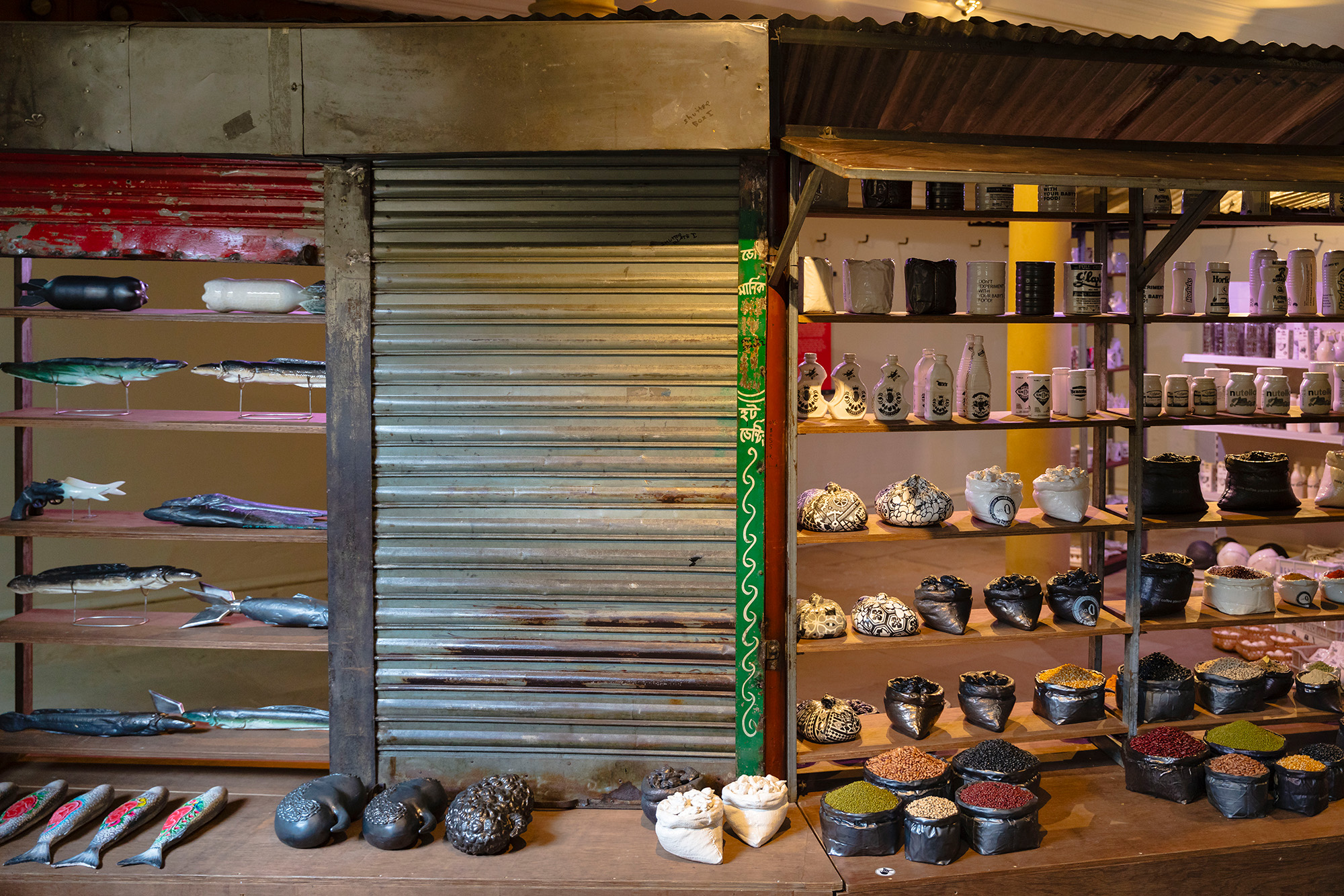


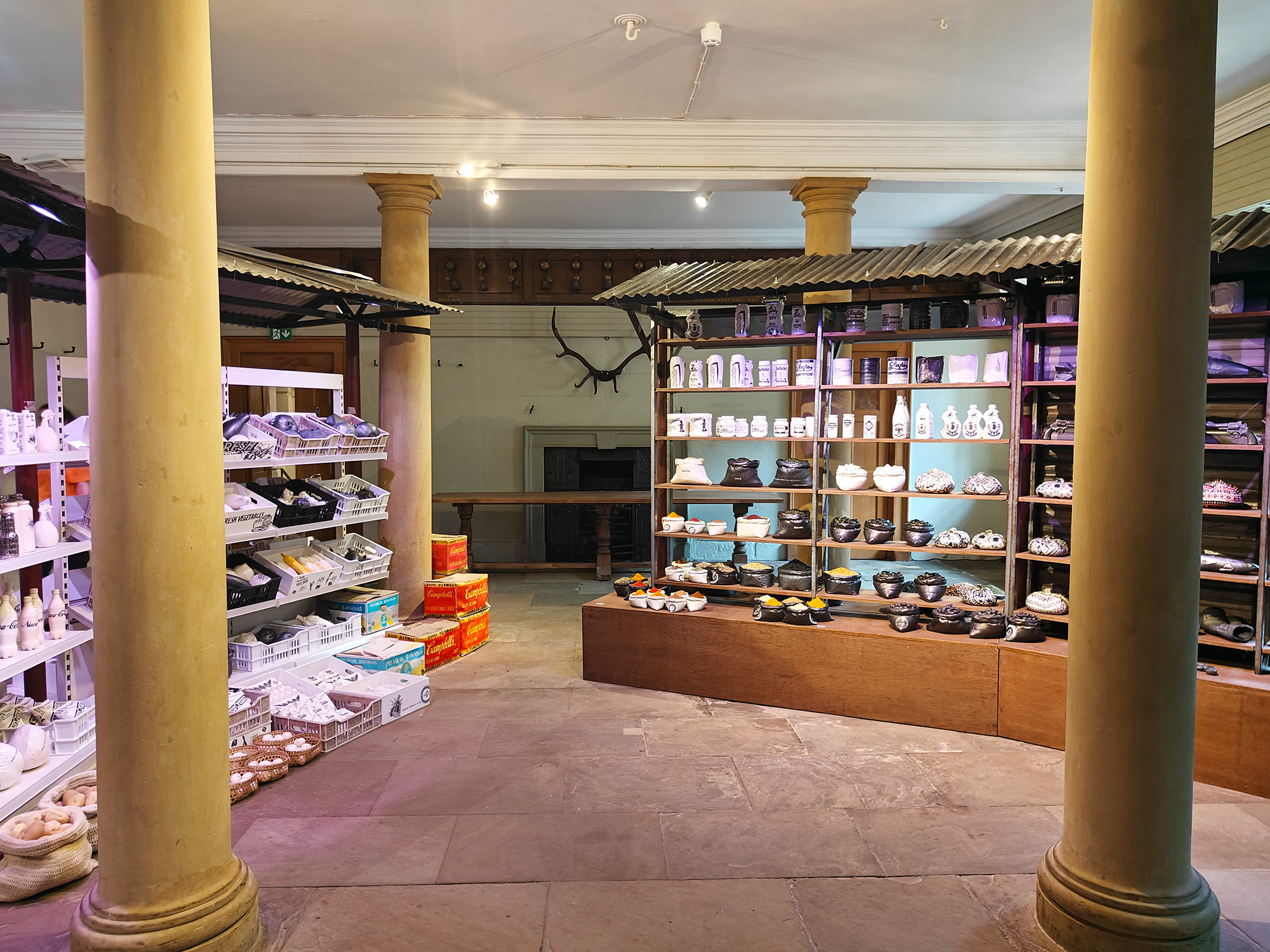
Figs.xxiii-xxvii
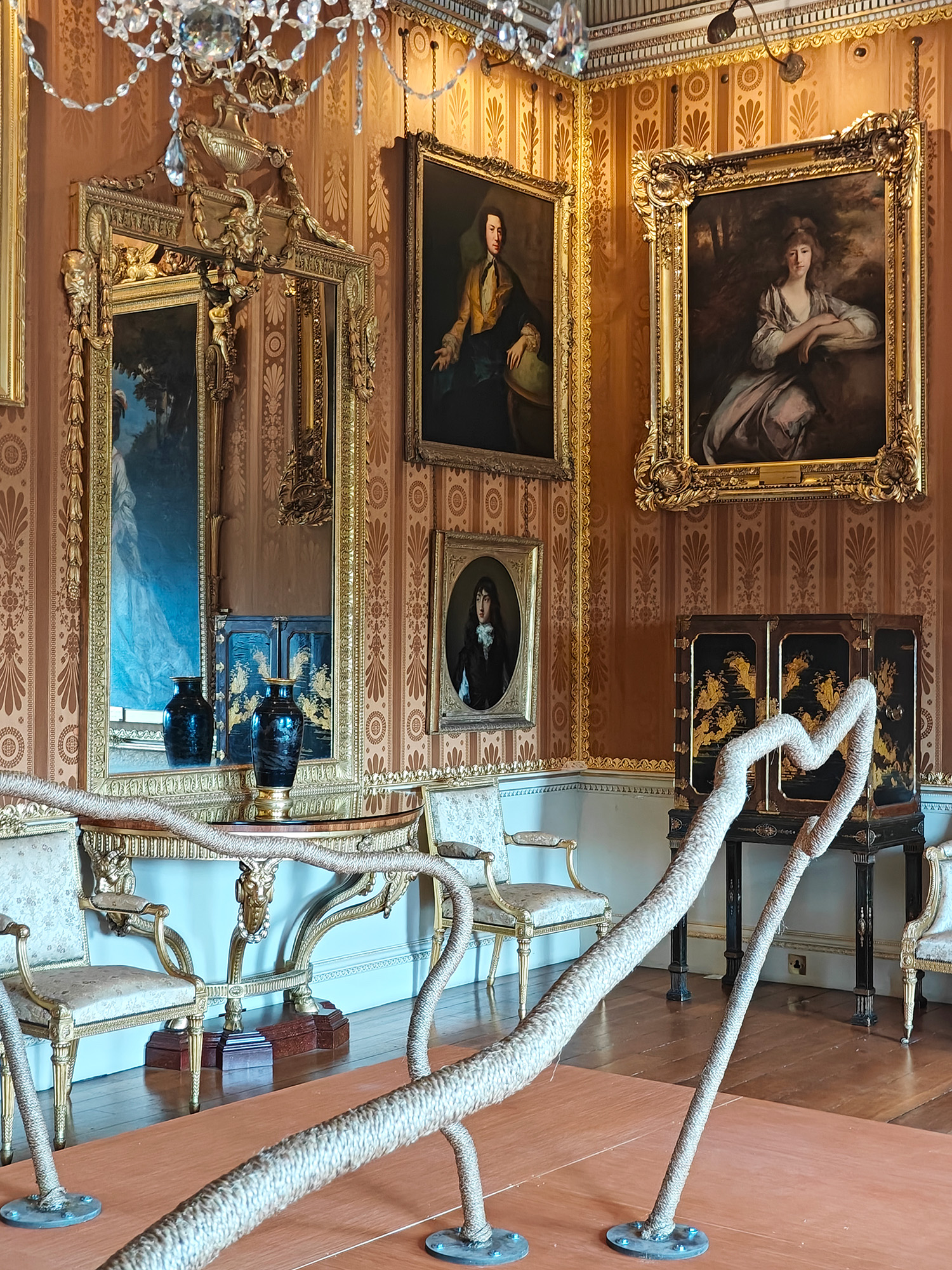
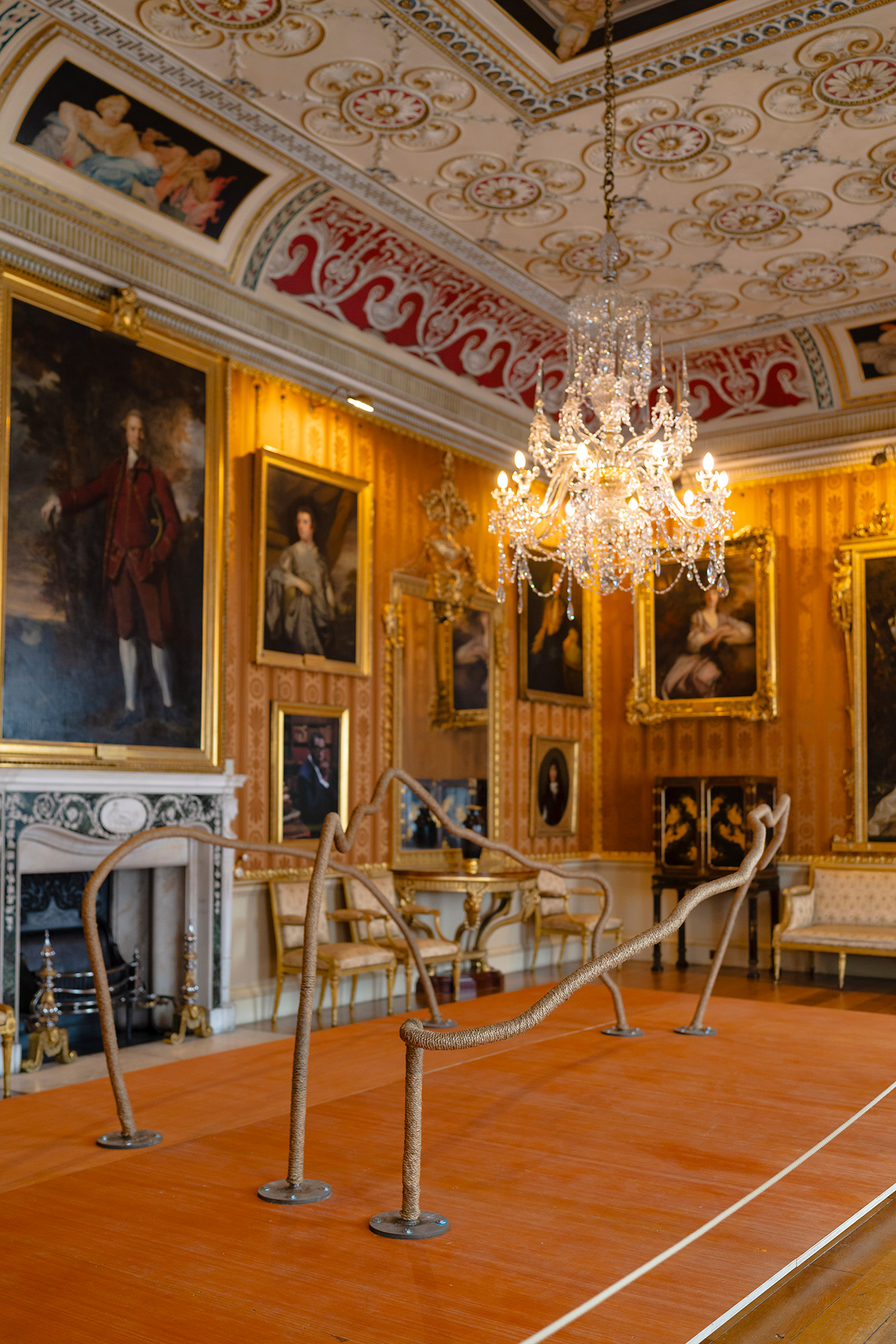
Figs.xxviii-xxxi
You will find Lagos in United Kingdom Living (2023)
Temitayo Ogunbiyi
Contorting and twisting its way across the ornate Harewood House Drawing Room, Temitayo Ogunbiyi’s sculpture takes inspiration from flight routes between Lagos and the UK. It’s a starting point to consider transnational movement for an artist thinking about a range of other references, including threaded hairstyles, the vines of Nigerian fruits, and the shapes of cooking vessels.
Originally presented at the South London Gallery’s Lagos, Peckham, Repeat, which we wrote about a year ago (00125), the work initiates new conversations when interrupting the mannered decorative order of the Cinnamon Drawing Room. Very much abstracted and extruded from its source references, the work sits in the space with deliberate awkwardness – pushing against the gilded frames, controlled representations, and architecture of power, but also playing along with elaborate filigree ornamentation, and intricate ceiling.
Temitayo Ogunbiyi
Contorting and twisting its way across the ornate Harewood House Drawing Room, Temitayo Ogunbiyi’s sculpture takes inspiration from flight routes between Lagos and the UK. It’s a starting point to consider transnational movement for an artist thinking about a range of other references, including threaded hairstyles, the vines of Nigerian fruits, and the shapes of cooking vessels.
Originally presented at the South London Gallery’s Lagos, Peckham, Repeat, which we wrote about a year ago (00125), the work initiates new conversations when interrupting the mannered decorative order of the Cinnamon Drawing Room. Very much abstracted and extruded from its source references, the work sits in the space with deliberate awkwardness – pushing against the gilded frames, controlled representations, and architecture of power, but also playing along with elaborate filigree ornamentation, and intricate ceiling.
The Essence of Home (2024)
BEIT Collective
Founded in 2021, BEIT Collective collaborates with designers and sculptors to celebrate, practice, and preserve traditional Lebanese handicrafts. The works here all speak to Corinthian column capitals, not only found architecturally across all Mediterranean nations but a motif upon common Lebanese household objects from meat mincers to kitchen sinks, vases to side tables.
All the pieces here, filling the main and side tables of the State Dining Room, are formed of various materials and made in collaboration with artisans and craftspeople, including those who have moved to Lebanon having been displaced by regional conflicts. Each is made to speak to different elements of the domestic sphere
BEIT Collective
Founded in 2021, BEIT Collective collaborates with designers and sculptors to celebrate, practice, and preserve traditional Lebanese handicrafts. The works here all speak to Corinthian column capitals, not only found architecturally across all Mediterranean nations but a motif upon common Lebanese household objects from meat mincers to kitchen sinks, vases to side tables.
All the pieces here, filling the main and side tables of the State Dining Room, are formed of various materials and made in collaboration with artisans and craftspeople, including those who have moved to Lebanon having been displaced by regional conflicts. Each is made to speak to different elements of the domestic sphere
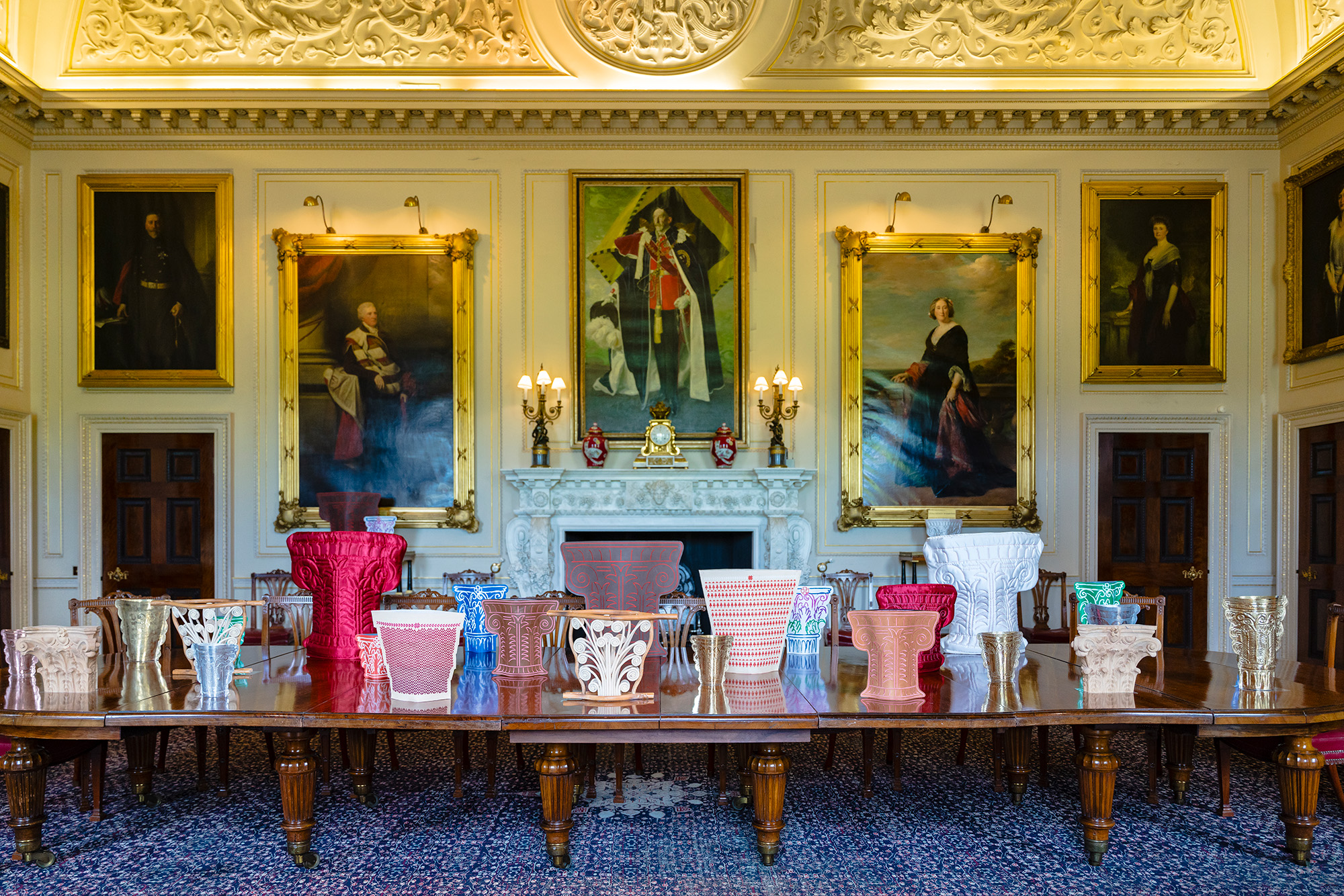

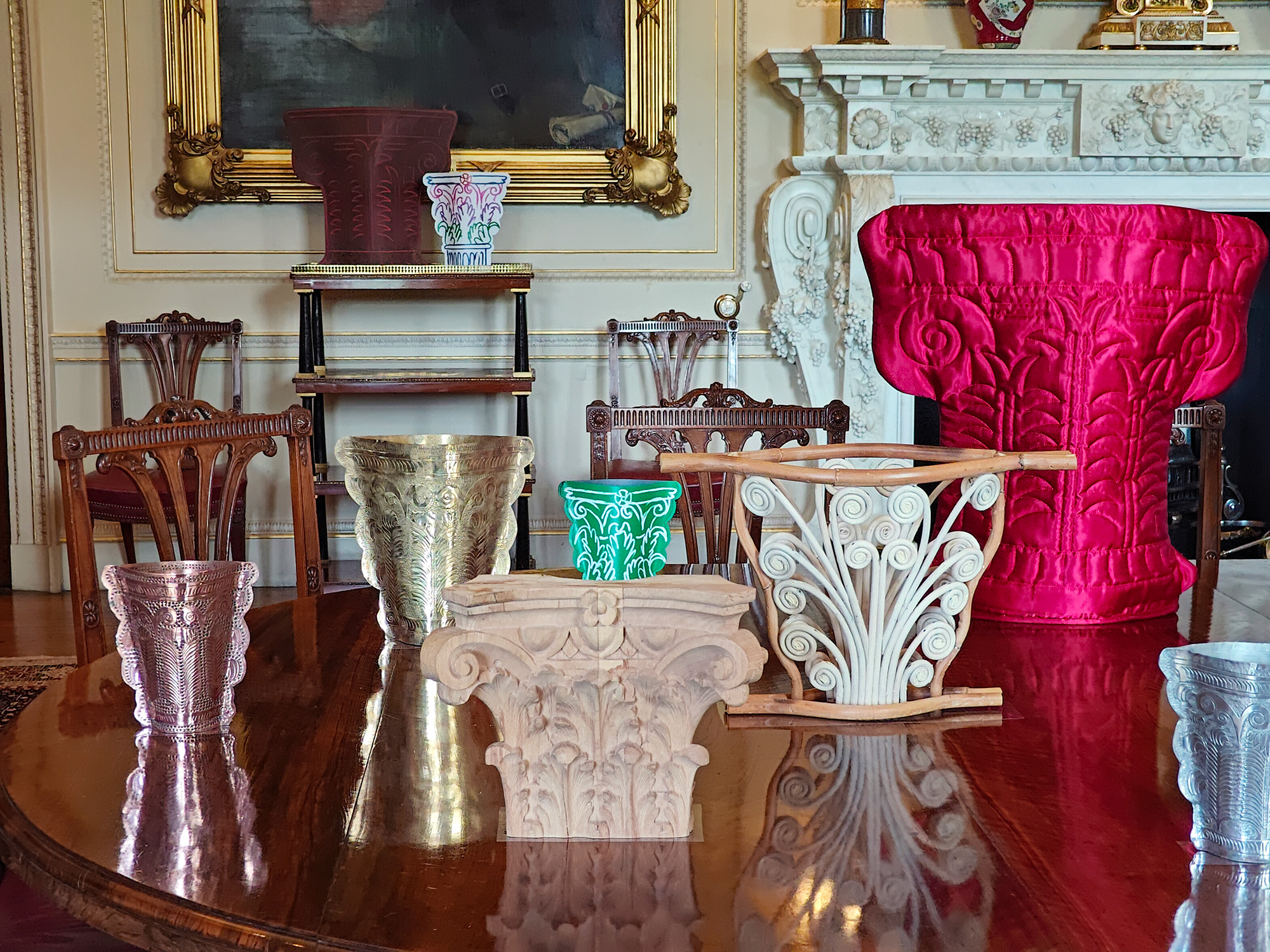
Figs.xxii-xxxv
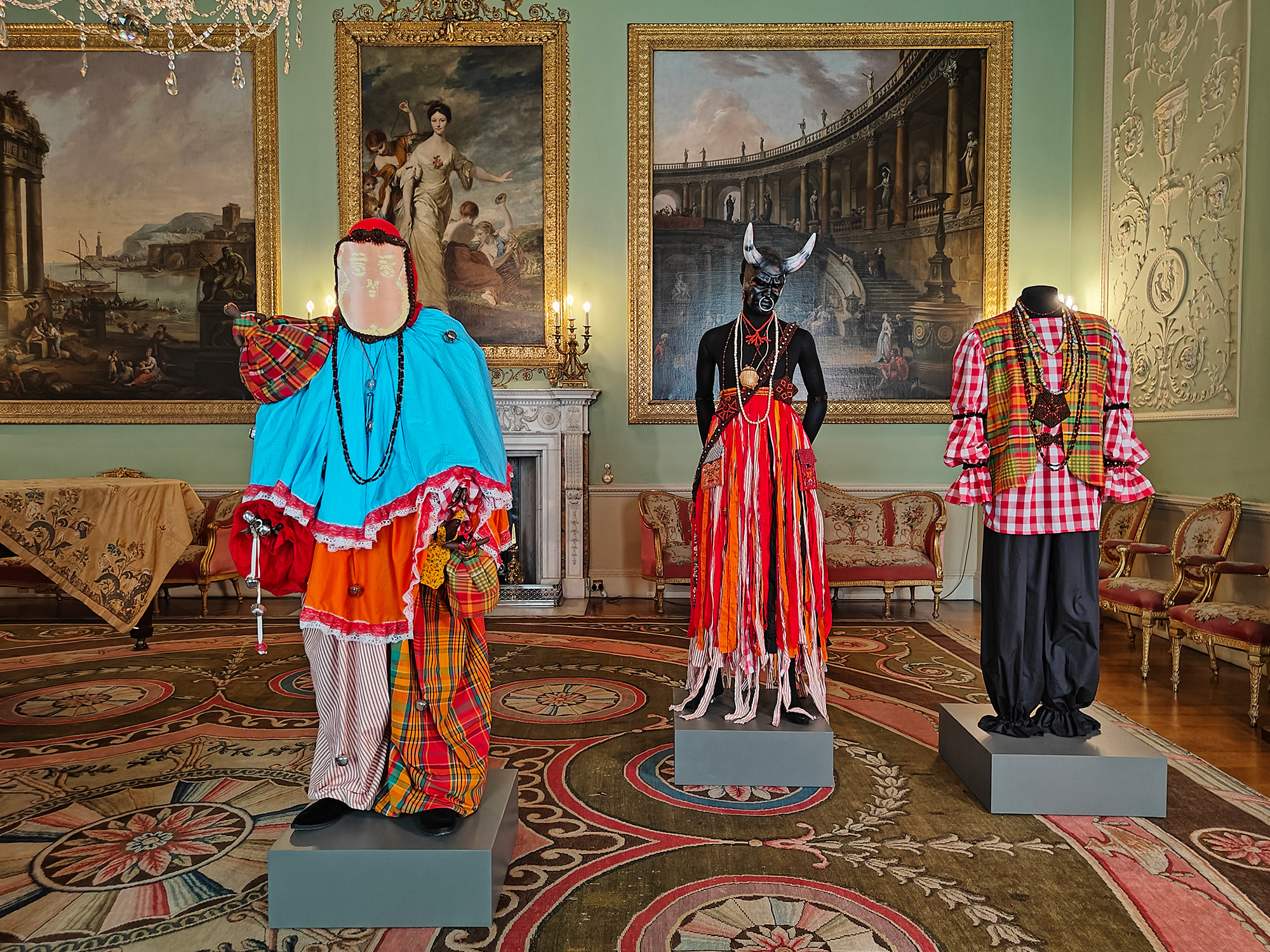
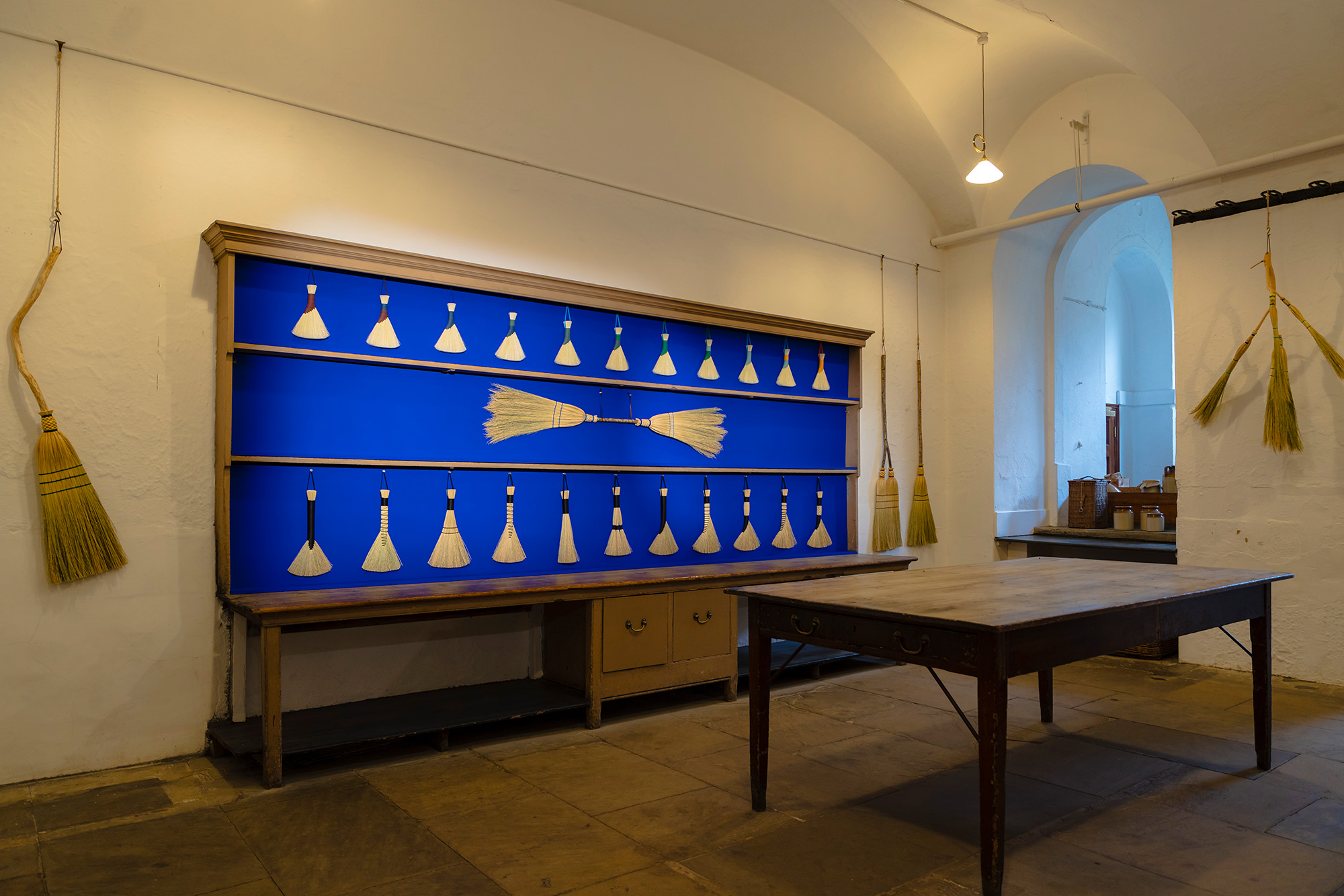


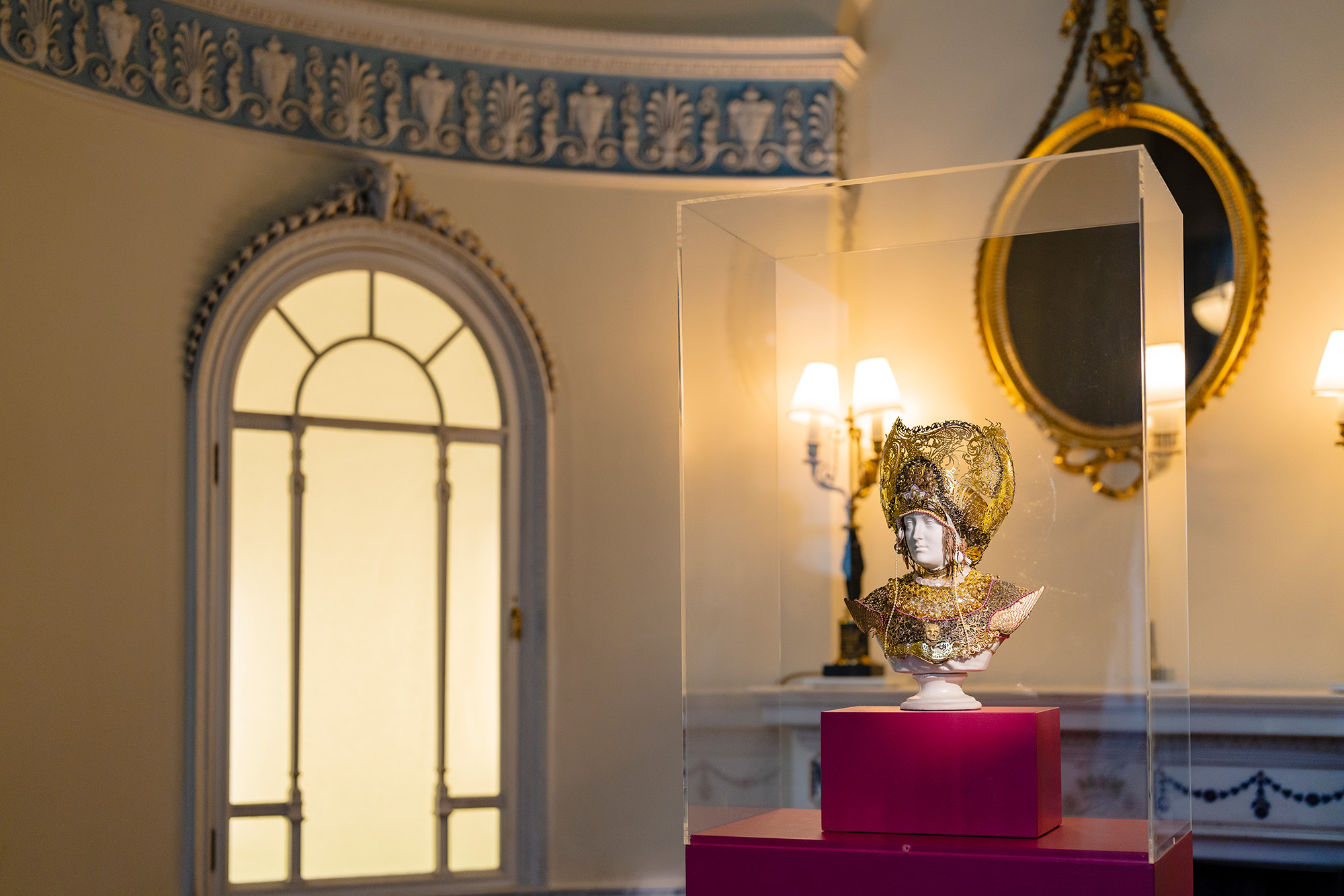
Figs.xxxvi-xxxix
Other rooms of Harewood House are home to projects by other
artists and designers, including jewellery from female Antigua and Barbuda collective Botanique Studios, a
cleverly represented decorative bust from Hew Locke, textiles from Jakup Ferri, and a series of handmade
brushes and brooms from Rosa Harradine.
Across all the works, Harewood House Biennial offers a rich way to explore the house and gardens, with new paths into the place’s complicated histories opened up through visual arts and design.
Across all the works, Harewood House Biennial offers a rich way to explore the house and gardens, with new paths into the place’s complicated histories opened up through visual arts and design.
Harewood House is managed by the Harewood House Trust, an
independent educational charity responsible for conserving Harewood House for
public benefit and the future. The Trust is leading the way to re-imagine what
makes a historic house and its landscape relevant in the 21st century.
Harewood House is the Grade I listed historic home of the
Earl and Countess of Harewood, welcoming around 250,000 visitors annually.
Building began in 1759 led by local architect John Carr, with interiors by
Robert Adam and the largest single commission of Thomas Chippendale furniture.
Lancelot ‘Capability’ Brown designed the 100 acres of nationally significant
gardens and landscapes. Inside the house, the collections include Renaissance
masterpieces, family portraits by Reynolds and Gainsborough and fine Sèvres
porcelain.
For over 30 years, David Lascelles and Diane Howse, the
current Earl and Countess, have provoked different perspectives and
conversations on Harewood House’s history, landscape and collections through
collaborations and commissions with contemporary artists. Harewood House Trust
has worked with artists including Anya Gallacio (1999), Mark Wallinger (2002),
Sonia Boyce (2007) and Thomas J Price (2015). More recently they launched
Harewood Biennial in 2019 and commissioned Hidden Portraits, a new series of permanently
displayed portraits including the founder of Leeds West Indian Carnival Arthur
France MBE and actor David Harewood OBE. This bold engagement with historical
narratives continues through the contemporary curatorial programme.
Future plans include a reimagined garden and
landscape from The Landscape Agency in partnership with award-winning garden
designer Matthew Wilson, a new play space in collaboration with
environmentalist Sebastian Cox and Touchwood, and a welcome centre with tea
house in the former Bake House
www.harewood.org
visit
Harewood House Biennial 2024: Create/Elevate runs at Harewood House through to 20 October.
Harewood
Biennial 2024: Create/Elevate is
curated by Darren Pih & Ligaya Salazar. This is the third edition of the
biennial presented by Harewood House Trust. Create/Elevate is supported by Arts
Council England, British Council & The Henry Moore Foundation.
Further details available at: www.harewood.org/whats-on/event/harewood-craft-biennial-create-elevate
images
fig.i Harewood House front the North Front. ©
Simon Warner and Harewood House Trust.
fig.ii Yellow Drawing Room. ©
Harewood House Trust.
figs.iii-vi,xiv,xv,xxiv,xxvi,xxvii,xxxi,xxxii,xxxv-xxxiv Photographs © Will Jennings.
fig.viii ‘Conditions at Present’ by Rebecca Chesney. Photo © Matthew Savage.
figs.ix,x Rebecca Chesney, ‘Conditions at Present’ at Harewood Biennial 2024 Create Elevate. © Drew Forsyth.
fig.xi-xiii Lucia Pizzani, ‘Cultivo y Memoria’ at Harewood Biennial 2024 Create Elevate, The Walled Vegetable Garden. © Drew Forsyth.
fig.xvi ‘Layered Legacies’ by Mani Kambo at Harewood Biennial 2024 Create Elevate. © Mani Kambo.
fig.xvii,xviii Mani Kambo, ‘Layered Legacies’ Commission for Harewood Biennial 2024 Create Elevate, Watercolour Room. © Drew Forsyth.
figs.xix,xx Arabeschi Di Latte, ‘Social Kitchen’ in Harewood House’s Old Kitchen. © Drew Forsyth.
figs.xxi,xxiii Modular by Mensah, ‘Onipa ye de’ at Harewood Biennial 2024 Create Elevate, Watercolour Room 2. © Drew Forsyth.
figs.xxiii,xxv,xxvii Harewood Biennial 2024, Britto Arts Trust. © Drew Forsyth.
figs.xxviii-xxx Temitayo Ogunbiyi, ‘You Will Find Lagos in United Kingdom Living’ at Harewood Biennial 2024 Create_Elevate, Cinnamon Drawing Room. © Drew Forsyth.
figs.xxiii,xxiv Harewood Biennial 2024 Create Elevate, BEIT Collective ‘The Essence of Home’ in Harewood House’s State Dining Room. © Drew Forsyth.
fig.xxiii,xxv
Hew Locke ‘Souvenir 6 (Princess Alexandra 2019)’ in Princess Mary’s dressing room at Harewood Biennial 2024 CreateElevate. © Drew Forsyth.
publication date
09 August 2024
tags
Robert Adam, Arabeschi Di Latte, Charles Barry, BEIT Collective, Botanique Studios, Britto Arts Trust, Capability Brown, John Carr, Rebecca Chesney, Craft, Colonisation, Design, Ecology, Jakup Ferri, Harewood Biennial, Harewood House, Rosa Harradine, History, Hew Locke, Kusheda Mensah, Modular by Mensah, Trevor Nicholson, Temitayo Ogunbiyi, Darren Pih, Lucia Pizzani, Ligaya Salazar, Francesca Sarti, Jo Woffinden
Further details available at: www.harewood.org/whats-on/event/harewood-craft-biennial-create-elevate


